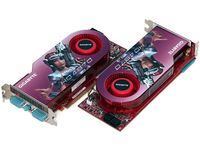Three High-End Liquid-Cooling Cases Compared
Test Configuration
Liquid cooling often offers excellent cooling capacity, but that wouldn’t matter much if hot case air destabilized another part of the system. In order to test both, we used an overclocked Intel Core 2 Quad processor to heat the liquid and a pair of HD 4870 X2 graphics cards to heat the air.
| Component | Details |
|---|---|
| CPU | 2x Intel Core 2 Quad Q96503.00 GHz, FSB-1333, 12 MB CacheOverclocked to 3.80 GHz, FSB-1688, 1.425V |
| Motherboard | Asus P5E3 PremiumIntel X48 Express, BIOS 0402 (04/21/2008) |
| RAM | 2x Crucial Ballistx BL12864BA16082x 1024MB DDR3-1600 DIMMOverclocked to DDR3-1688, 1.90V |
| Graphics | 2x Gigabyte GV-R487-512H-BAMD Radeon HD 4870 GPU (750 MHz)512 MB GDDR5-3600 (Per Card) |
| Hard Drive | Western Digital Caviar WD5000AAKS500 GB, 7200 RPM, 16 MB Cache |
| Sound | Integrated ADI 1988B Codec |
| Network | Integrated Gigabit Networking |
| Power | Ultra X3 1000W Modular |
| Chipset Driver | Intel INF 9.0.0.1008 |
| Graphics Driver | AMD Catalyst 8.8 |
| OS | Windows Vista Ultimate 32-bit, SP1 |
New to today’s tests are a pair of Gigabyte HD 4870 graphics cards in Crossfire mode. AMD’s recent graphics processors are famed for both high gaming power and high power consumption, and should assist in our evaluation of case temperatures as other components compensate for the high electrical demands and intense workloads.
System performance doesn’t change with temperature unless a processor reaches its “thermal throttling” threshold. Since these cases are more than adequate for keeping components below their thermal thresholds at full load, benchmark performance wouldn’t be an issue. Focusing instead on cooling capability only required us to approximated full load prior to taking our temperature readings.
| 3D Mark 2006 | Resolution: 1920x1200Video Quality: 4x AA, 8x AFTest: Perlin Noise (SM 3.0), Looping |
| Prime95 Version 24.14 | Test: Small FFT’sNumber of Instances: Four |
All components were run at the above load for several hours before taking temperature readings.
Get Tom's Hardware's best news and in-depth reviews, straight to your inbox.
Current page: Test Configuration
Prev Page Tom’s Hardware’s Liquid-Cooled Case Next Page Cooling Performance
